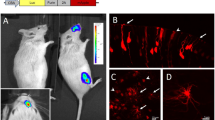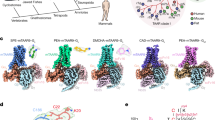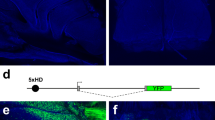Abstract
THE onset of olfactory transduction has been extensively studied1–7, but considerably less is known about the molecular basis of olfactory signal termination6,8,9. It has been suggested that the highly active cytochrome P450 monooxygenases of olfactory neuroepithelium10–12 are termination enzymes5,8,11,12, a notion supported by the identification and molecular cloning of olfactory-specific cytochrome P450s (refs. 13–16). But as reactions catalysed by cytochrome P450 (refs 17, 18) often do not significantly alter volatility, lipophilicity or odour properties9,11, cytochrome P450 may not be solely responsible for olfactory signal termination. In liver and other tissues, drug hydroxylation by cytochrome P450 is frequently followed by phase II biotransformation, for example by UDP glucuronosyl transferase (UGT), resulting in a major change of solubility and chemical properties19. We report here the molecular cloning and expression of an olfactory-specific UGT. The olfactory enzyme, but not the one in liver microsomes, shows preference for odorants over standard UGT substrates. Furthermore, glucuronic acid conjugation abolishes the ability of odorants1,20 to stimulate olfactory adenylyl cyclase. This, together with the known broad spectrum of drug-detoxification enzymes17,19, supports a role for olfactory UGT in terminating diverse odorant signals.
This is a preview of subscription content, access via your institution
Access options
Subscribe to this journal
Receive 51 print issues and online access
$199.00 per year
only $3.90 per issue
Buy this article
- Purchase on Springer Link
- Instant access to full article PDF
Prices may be subject to local taxes which are calculated during checkout
Similar content being viewed by others
References
Pace, U., Hanski, E., Salomon, Y. & Lancet, D. Nature 316, 255–258 (1985).
Sklar, P. B., Anholt, R. R. & Snyder, S. H. J. blol. Chem. 261, 15538–15543 (1986).
Shirley, S. G., Robinson, C. J., Dickinson, K., Aujla, R. & Dodd, G. H. Biochem. J. 240, 605–607 (1986).
Lancet, D. & Pace, U. Trends biochem. Sci. 12, 63–66 (1987).
Lancet, D., Lazard, D., Heldman, J., Khen, M. & Nef, P. Cold Spring Harbor Symp. quant. Biol. 53, 343–348 (1988).
Snyder, S. H., Sklar, P. B., Hwang, P. M. & Pevsner, J. Trends Neurosci. 12, 35–38 (1989).
Reed, R. R. Cell 60, 1–2 (1990).
Getchell, T. V., Margolis, F. L. & Getchell, M. L. Prog. Neurobiol. 23, 317–345 (1984).
Lancet, D. A. Rev. Neurosci. 9, 329–355 (1986).
Dahl, A. R., Hadley, W. M., Hahn, F. F., Benson, J. M. & McClellan, R. O. Science 216, 57–59 (1982).
Dahl, A. R. in Molecular Neurobiology of the Olfactory System (eds Margolis, F. L. & Getchell, T. V.) (Plenum, New York, 1988).
Jenner, J. & Dodd, G. H. Drug Metabol. Drug Interact. 6, 123–148 (1988).
Nef, P. et al. J. biol. Chem. 264, 6780–6785 (1989).
Ding, X. X. & Coon, M. J. Biochemistry 27, 8330–8337 (1988).
Nef, P., Larabee, T. M., Kagimoto, K. & Meyer, U. A. J. biol. Chem. 265, 2903–2907 (1990).
Lazard, D. et al. Biochemistry 29, 7433–7440 (1990).
Black, S. D. & Coon, M. J. Adv. Enzym. 60, 35–87 (1987).
Nebert, D. W. & Gonzalez, F. J. A. Rev. Biochem. 56, 945–993 (1987).
Burchell, B. & Coughtrie, M. W. Pharmac. Ther. 43, 261–289 (1989).
Pace, U. & Lancet, D. Proc. natn. Acad. Sci. U.S.A. 83, 4947–4951 (1986).
Mackenzie, P. I., Chowdhury, N. R. & Chowdhury, J. R. Clin. exp. pharmacol. Physiol. 16, 501–504 (1989).
Pfeuffer, E., Mollner, S., Lancet, D. & Pfeuffer, T. J. biol. Chem. 264, 18803–18807 (1989).
Fenaroli, G. Fenaroli's Handbook of Flavor Ingredients (eds Furia, E. T. & Bellanca, N.) (CRC, Cleveland, 1975).
Lazard, D., Barak, Y. & Lancet, D. Biochim. biophys. Acta 1013, 68–72 (1989).
Voigt, J. M., Guengerich, F. P. & Baron, J. Cancer Lett. 27, 241–247 (1985).
Foster, J. R. et al. Biochem. Pharmacol. 35, 4543–4554 (1986).
Shepherd, S. R., Baird, S. J., Hallinan, T. & Burchell, B. Biochem. J. 259, 617–620 (1989).
Crawford, J. M. & Gollan, J. L. Am. J. Physiol. 255, 121–131 (1988).
Gander, J. E. & Mannering, G. J. Pharmac. Ther. 10, 191–221 (1980).
Shipley, M. T. Brain Res. Bull. 15, 129–142 (1985).
Talamo, B. R. et al. Nature 337, 736–739 (1989).
Wilbur, W. & Lipman, D. Proc. natn. Acad. Sci. U.S.A. 80, 726–730 (1983).
Mackenzie, P. I. J. biol. Chem. 261, 6119–6125 (1986).
Mackenzie, P. I. J. biol. Chem. 262, 9744–9749 (1987).
Sompayrac, L. M. & Danna, K. J. Proc. natn. Acad. Sci. U.S.A. 78, 7575–7578 (1981).
Graham, F. L. & Van der Eb, A. J. Virology 52, 456–467 (1973).
Bansal, S. K. & Gessner, T. Analyt. Biochem. 109, 321–329 (1980).
Salomon, Y., Londos, C. & Rodbell, M. Analyt. Biochem. 58, 541–548 (1974).
Author information
Authors and Affiliations
Rights and permissions
About this article
Cite this article
Lazard, D., Zupko, K., Poria, Y. et al. Odorant signal termination by olfactory UDP glucuronosyl transferase. Nature 349, 790–793 (1991). https://doi.org/10.1038/349790a0
Received:
Accepted:
Issue Date:
DOI: https://doi.org/10.1038/349790a0
This article is cited by
-
Characterization of human oxidoreductases involved in aldehyde odorant metabolism
Scientific Reports (2023)
-
UDP-glycosyltransferase genes and their association and mutations associated with pyrethroid resistance in Anopheles sinensis (Diptera: Culicidae)
Malaria Journal (2019)
-
Vapor detection and discrimination with a panel of odorant receptors
Nature Communications (2018)
-
Comparative transcriptome analysis of Apis mellifera antennae of workers performing different tasks
Molecular Genetics and Genomics (2018)
-
The human olfactory transcriptome
BMC Genomics (2016)
Comments
By submitting a comment you agree to abide by our Terms and Community Guidelines. If you find something abusive or that does not comply with our terms or guidelines please flag it as inappropriate.



